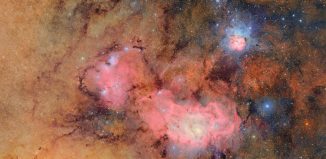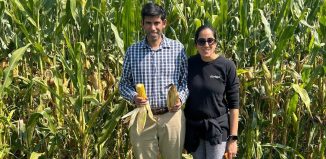BNL’s Bolotnikov a radiation detector innovator
Looking through binoculars from the bleachers at a baseball game, at an eagle as it alights on a distant tree or at a constellation in a cloudless night are all much easier with a clear lens. A smudge, crack or even a hair on the lens can make that long-distance gazing considerably more challenging, as the images become blurry and our eyes struggle to interpret the difference between what’s out there and the defect in our binoculars.
The same holds true for radiation detectors. Constructed with bars of crystals, the detectors have applications in everything from medical imaging to see tumors to peering deep into the universe for signature radiation signals to detecting the movement of nuclear materials to help prevent an attack or accident.
A significant challenge with these detectors has been the defects that appear as the crystal grows. Scientists work on two fronts to deal with these imperfections: They improve the quality of the crystals, and they develop ways to compensate for the imperfections.
At Brookhaven National Laboratory, physicist Aleksey Bolotnikov has made significant contributions to improving detector performance despite the flaws in the crystal.
“We veto the interactions in the ‘bad’ regions of the crystals,” Bolotnikov explained.
Working with a team of scientists at BNL, including Giuseppe Camarda, Utpal Roy, Anwar Hossain and Ge Yang, Bolotnikov has been able to measure the coordinates of these defects with high accuracy. This allows the researchers to improve the detecting capability and reduce the cost by increasing the acceptance rates of the crystals.
Recently, Bolotnikov authored a paper in Applied Physics Letters in which he increased the size and thickness of the crystals. The thicker crystals are important in detecting weak sources.
Bolotnikov has “been able to establish new records for the thickness of semiconductor gamma-ray detectors operating at room temperature,” offered Ralph James, who heads Bolotnikov’s department and has collaborated with him ever since he arrived 20 years ago. “This is a critical step in the move to replace many traditional radiation-sensing instruments used today.”
The biggest market for these detectors with thicker crystals is in nuclear medical instruments for oncology and cardiology, James said.
Bolotnikov explained that the team at BNL combines researchers with expertise in a range of areas. Roy grows the crystals, while a group from the instrumentation division led by Gianluigi De Geronimo facilitates the work as a “top expert in readout electronics.” By tapping into his expertise in nuclear physics and nuclear engineering, Bolotnikov is also able to design and develop new detectors.
James credits his colleague with significant advances in detector technology. “His new position-sensitive device design has rendered outstanding results that have approached the theoretical limits for energy resolution,” James said.
The work of Bolotnikov and the team has earned them national recognition. Bolotnikov was a part of three R&D Magazine’s R&D 100 Awards, in 2006, 2009 and 2014.
Last fall, he received the Room Temperature Semiconductor Detector Scientist Award from the Institute of Electrical and Electronics Engineers. The award recognized a scientist who had done the most to impact room temperature semiconductor detectors and could be given either for a lifetime of work or for a single accomplishment.
The award is “well earned,” James said. Bolotnikov’s votes among the awards committee “surpassed others by far.”
Like other members of his team, James said Bolotnikov works most waking hours. “I can count on a quick response from him via emails during the evenings,” James said.
Born in a small city near Moscow, Bolotnikov first came to Long Island around 1991. He now lives in Setauket with his wife Mila, who is a teacher for North Shore Montessori. His daughter Dasha works at BlackRock, while his son Vassili works for a small management company affiliated with Stony Brook Hospital.
Bolotnikov, who said he enjoys his work, suggested that the effort to improve technology generates new ideas, which “creates the new background or basis for writing proposals for the next cycle of work.”
Bolotnikov continues to work on increasing the size of the crystals in the detectors. At some point, the larger sizes can become prohibitively expensive. An alternative, he suggested, is to use gamma-ray focusing optics, concentrating gamma rays coming from large areas toward a reasonably sized detector. “This, he said, “is a new horizon.”






